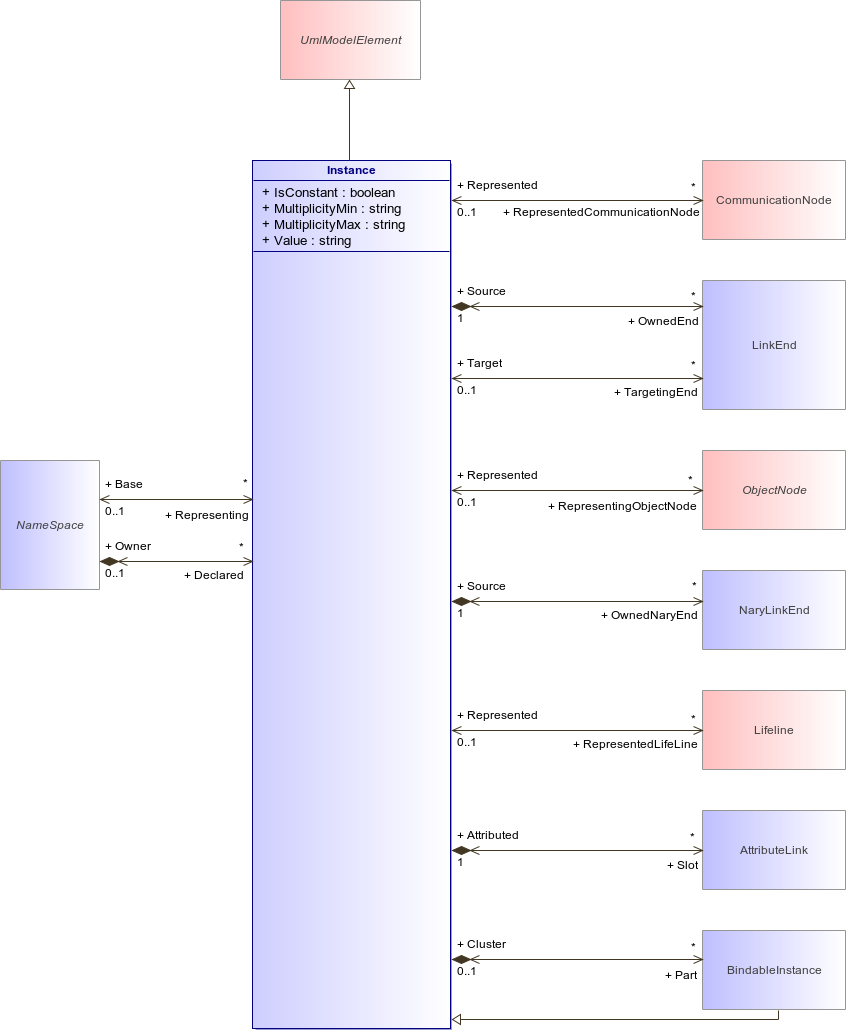
UML/BPMN Metamodel
Representation of an Instance in a modeled system, or role played by Instances in a certain context.
In Modelio, Instances represent both the UML 2.0 Instance specification, and the UML 2.0 Part within structured Classifiers. The distinction is made through the definition context. If the context is a namespacing context (such as Package or Class), then it corresponds to the UML 2.0 instance specification. If the context of the instance is an instantiation context, such as typically in the case of Collaborations, then it corresponds to Parts. Parts and Ports are handled as instances in Modelio, whereas UML 2.0 handles them as properties.
An Instance is connected to zero or several Classifiers, which declare its structure and behavior. It has a set of attribute values (Slot in UML, and AttributeLink in Modelio) and is connected to a set of Links, where both sets match the definitions of its Classifiers/NameSpaces (if there are any). The two sets implement the current state of the Instance.
In Modelio, an Instance belongs to its NameSpace (Class, Package, Collaboration, and so on), or to another Instance (Cluster association).
There exist three important cases of configuration for instances in Modelio:
1 - The Instance belongs to a Package. This corresponds to the UML 2.0 notion of InstanceSpecification.
2 - The Instance belongs to a Collaboration (it is a Part, and its links are Connectors).
3 - The Instance belongs to a Classifier. In this case, it is a Part or a Port of the Classifier.
(UML 2.0 semantics): When an Instance of the containing Classifier is created, a set of Instances corresponding to its properties may be created either immediately or at some later time, depending on the multiplicity. These Instances are Instances of the Classifier typing the property.
A Part specifies that a set of Instances may exist. This set of Instances is a subset of the total set of Instances specified by the Classifier typing the Part. A Part of a Classifier declares that an Instance of this Classifier may contain a set of Instances by composition. All such Instances are destroyed when the container Classifier Instance is destroyed.
In Modelio, an Instance belongs to another Instance (embedded or clustered Instances) or belongs to a NameSpace (Package, Class, Collaboration).


Figure 216 : Instance (architecture_autodiagram)
Attribute | Description |
|---|---|
boolean IsConstant [1..1] | Determines whether it is a constant. |
string MultiplicityMin [1..1] | Minimum number of Instances that can exist. In the case where the Instance belongs to a Collaboration (typically in the case of internalStructure) this represents the number of instances at the time of creation of the container NameSpace or Classifier. |
string MultiplicityMax [1..1] | Maximum number of Instances that can exist in the context of the owner NameSpace. |
string Value [1..1] | Current value of the Instance. This can be an expression, used instead of the set of values of the AttributeLinks of the instance. |
Association | Description |
|---|---|
Defines the Classifier as the model of the Instance or Role. | |
Occurrences of attributes for the current object (Instance or Role). | |
Instances can be embedded. This can represent cluster. In Modelio, this is used to represent ComponentInstance supported by NodeInstances, or Objects in ComponentInstances or NodeInstances. | |